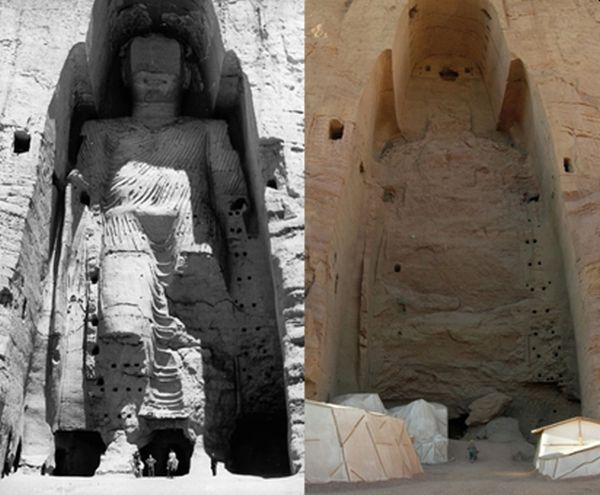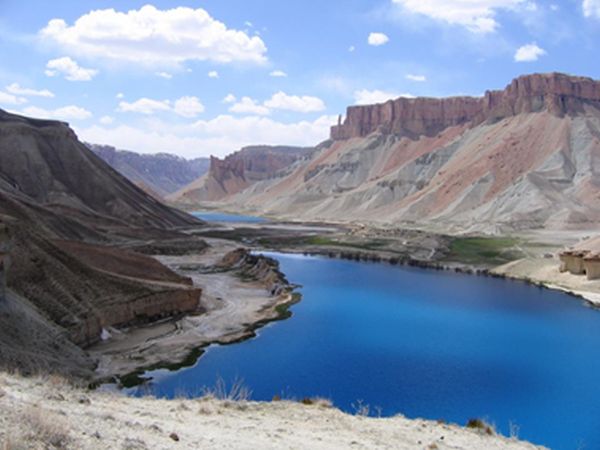Friedrich SCHIPPER , Blue Shield Austria | Wolfgang BÖRNER, ICOMOS Austria | August 18, 2021, 7 pm
An assessment of the status quo 2001 – 2021
During a several days’ campaign launched on 2 March 2001, the world observed the destruction of the “Buddhas of Bamiyan”, two 6th century monumental statues of Gautama Buddha, representing an icon of Gandhara art, carved into the sandstone cliff in the Bamiyan valley of central Afghanistan, about 130 kilometers northwest of Afghanistan’s capital city Kabul. This iconoclastic campaign was conducted by the Taliban that had seized power for the first time in 1996, establishing the Islamic Emirate of Afghanistan that had lasted until the capture of Kabul on 13 November 2001 by Allied Forces in the course of the Operation Enduring Freedom. About 20 Years later, on 15 August 2021, Kabul was re-captured by the Taliban putting an end to current international operations and missions.

Fig. 1: The landscape of the archaeological Remains of the Bamiyan Valley (© Alessandro Balsamo, CC BY-SA 3.0 igo)
Earlier this year the organizers of the 26th Conference on Cultural Heritage and New Technologies, ICOMOS Austria and the Wiener Stadtarchäologie, had published a call for short papers contributing to a Round Table on “Bamiyan World Heritage: The Present and The Future”, thereby marking the anniversary of its destruction and reflecting upon the status quo of the conservation and restoration after 20 years of work. However, due to the current line of events the Afghan chairpersons and speakers may not be able to join the international expert community soon about to gather in Vienna. Moreover, there is severe concern to be put in the first place about the safety and wellbeing of our Afghan colleagues, who have invested years of their life and work in preserving an iconic cultural heritage of their nation, the “Cultural Landscape and Archaeological Remains of the Bamiyan Valley”, as being listed by UNESCO as a World Heritage Site since 2003 – and simultaneously entered on UNESCO’s list of World Heritage in Danger. Generally, the threats to lives of professionals working in the field of culture, especially the ones that cooperated with international organizations, is of utmost concern as also expressed these days by the competent authorities of UNESCO. So far, as retrieved today, the UNESCO Office in Kabul is still operative and the staff is working to obtain more information, especially assessments of concrete sites, including World Heritage Sites. During the first days of renewed Taliban rule over Afghanistan, fortunately no atrocities against such guardians of Afghan culture and heritage have been confirmed.

Fig. 2: Taller, 55 meter Buddha in 1963 and in 2008 after destruction (© Zaccarias, CC BY-SA 3.0)
Earlier this year, in March 2021, UNESCO had set out to commemorate the 20 years since the destruction of two Buddhas. Ernesto Ottone, Assistant Director-General for Culture, stated that since the destruction, “thanks to solid and lasting international cooperation, more than USD$ 27 million had been invested in the conservation and stabilization of the Bamiyan World Heritage property, the empowerment of local communities, the revitalization of intangible cultural heritage, and the construction of a Cultural Centre for Bamiyan dedicated to creativity, among other activities.” Yet, beyond international cultural politics, the Afghan experts to chair the Vienna Round Table on Bamiyan, Alireza Ibrahimi and Hosein Rezaei, both from Aviccena University Kabul, concluded that “unfortunately, after 20 years, the preservation and reconstruction of Bamiyan World Heritage have not progressed as expected and even these days we see many walls and caves of Buddha statues falling due to erosion by sunlight and rain.”
The Vienna Round Table on Bamiyan, scheduled to take place in November this year, was intended to invite researchers, experts in government and international organizations to review their role in the conservation of Bamiyan World Heritage and the following topics:
- The status of the reconstruction of the Buddha statues and future ahead
- Obstacles and problems in preservation the Bamiyan World Heritage
- New technologies towards conservation and reconstruction of Bamiyan World Heritage
Due to the current dramatic events in Afghanistan, the unpredictability of the situation in the upcoming days and probably weeks, and the urgency for information, a summary report of the abstracts submitted for the Vienna Round Table on Bamiyan is hereby provided.
Mohammad Reza Paiman, Nasibe Sadafi, and Tayebeh Nazaria, all three are scholars from Payam-e Noor University in Kabul and Tehran, have assessed the condition of the historic network of sidewalks of the habitat between the Buddhas and the residential places of Bamiyan Valley. Despite all national and international efforts to maintain and restore the infrastructure of the cultural landscape of the Bamiyan Valley including Bamiyan City and several towns and villages in the area the condition of this infrastructure remains poor. At the same time, the native population has declined over the past 20 years, while migrants have settled in. In consequence, the old social fabric of the society of Bamiyan Valley is fading away and therefore social and economic life is eroding as well as the welfare system that had developed basically over centuries. The main purpose of this research is to and improve the sidewalks of the World Cultural Heritage Landscape and thereby to contribute to the revitalizing the social and economic life in the area.

Fig. 3. Sidewalks of Bamiyan Valley, Afghanistan (© Tayebeh Nazarian).
Marzieh Karimia, University of Tehran, and Mohammad Reza Amirib, Avicenna University and Kateb University, have investigated the factors and risks threatening the environmental status of the water bodies in Band-e Amir National Park in Bamiyan Province, which is a series of six deep blue lakes separated by natural dams made of travertine, a mineral deposit. The lakes are situated in the Hindu Kush mountains at approximately 3000 m of elevation, west of the Buddhas. The Natural Park of Band-e Amir has been described as Afghanistan’s Grand Canyon and usually draws thousands of tourists a year. In 2009, Band-e Amir was registered as the first national nature park in Afghanistan to protect the lakes and the landscape and prevent the extinction of animal and plant species. Accelerated human activities threaten the environment from two perspectives: 1. Local people threaten protected areas and pollute the environment by destroying habitats and farms to provide firewood in the cold season, overgrazing and overhunting animals and aquatic animals, with special fishing methods including the use of hand-thrown grenades and explosions in the lake; 2. The presence of tourists in certain seasons and unplanned ecotourism lead to the degradation of the natural ecosystem due to water and soil pollution induced by the release of waste and settling in nature.
 Fig. 4: View of Band-e Amir, Bamiyan Province, Afghanistan (© USAID).
Fig. 4: View of Band-e Amir, Bamiyan Province, Afghanistan (© USAID).
Zakaria Ahmadi, Aga Khan Cultural Service Afghanistan, and Hosein Rezaei, Aviccena University Kabul, examined the architectural ornaments of temple ceilings at Bamiyan identifying different types of ornaments and assessed the impact of the ornaments on the architecture of the region. Geometric shapes in temples are divided into two categories: the first category is simple geometric patterns such as squares and circles, and the basic geometric shapes, the second category are nodes which includes a set of geometric shapes coordinated and arranged together with symmetric order and screws and breakers. The symbolic values of these shapes can be comprehended by interpreting and deciphering special numbers and shapes used in these reliefs.
 Fig 5: geometric ornaments of a temple ceiling (© Zakaria Ahmadi)
Fig 5: geometric ornaments of a temple ceiling (© Zakaria Ahmadi)
Ateyeh Heydari and Mohammad Mahdi Salehi, both from Avicenna University in Kabul, have assessed of the factors affecting the physical resilience of Bamiyan cultural heritage against climate change. Afghanistan is the 11th most vulnerable country impacted by the climate change effects and Bamiyan Valley as one of its ancient cities is located in Afghanistan’s central highlands as one of the most vulnerable areas in the country. Competition over and mismanagement of the province’s limited arable land has resulted in wide-spread soil erosion, the denuding of natural vegetation, and degradation of rangelands. Coupled with these environmental issues is an increased risk of natural disasters such as flood and drought, particularly as a result of climate change. The new forecasts of climate change show that Afghanistan’s raining level will remain relatively constant until the year 2100, however, the general temperature’s hike in all over the country leads into rising evaporation which cannot be compensated by inadequate raining. Therefore, it will have a negative effect on water resources access and cycle, which increase the risks of vegetation degradation, desertification, erosion, floods, avalanche, and landslide. In addition, temperature’s hike begins glacial melting in Hindukush area, which negatively affects underwater resources. Bamiyan as one of the oldest historical areas of Afghanistan with several ancient sites is being affected and will be affected more in the future by the climate change driven natural hazards. The condition of six ancient monuments were examined against the effects of natural hazards caused by climate change including drought, landslide, flood, and avalanche. Protection plans were proposed to mitigate the adverse effects of the hazards.
Mohammad Movahedi, Hosein Rezaei, Qurban Ali Amiri, and Zahra Mirzaie carried out investigations on the short, mid and long-term effect of destructive factors on the Buddha statutes of Bamiyan and to map them in order to maintain and protect them supported by applying GIS tools. All threatening factors for the Bamiyan study area including 5 natural factors (earthquake, rainfall, humidity, temperature fluctuation and erosion) and 4 human factors (road construction through the historical area, building construction in the historical area, tourism and unauthorized drilling) were determined and evaluated using hierarchical analysis method in order to systematically monitor the maintenance and management of the heritage site. The researchers charted the nature of the risks and scope of their impact in order to achieve a general risk map and to show the risk zones with low, moderate and high risks. This map has a significant impact on solving many restoration challenges, as well as the systematic monitoring in order to optimize the risk preparedness.
Mohammad Reza Amiria, Avicenna University and Kateb University in Kabul, and Marzieh Karimib, University of Tehran, carried out investigations on the potential of artificial intelligence in the development of sustainable tourism in Bamiyan. There is substantial potential for a tourism hub in Afghanistan in the legendary city of Bamiyan with its many historical monuments dating from different historical periods. The destroyed Buddha statues, Zahak city, Ghalghaleh city and thousands of caves (small and large) on Bamiyan’s landscape have made this place a world heritage site. Although Bamiyan is world-famous, it has not attracted much attention from foreign tourists due to a lack of infrastructure and security. At present, our primary focus in Afghanistan’s tourism development is to introduce to the world the untouched places that have cultural and historical significance. With 3D pictures and direct communication, tourists will be offered information at anytime, anywhere, with high efficiency and low cost, which in return will help Afghanistan’s tourism thrive. The study tries to identify the existing potential for virtual tourism in Bamiyan city and to revitalize tourism and provide a set of solutions, examines the use of artificial intelligence and virtual tourism in the development of Bamiyan tourism.

Fig. 6: People watch a three-dimensional projection at the site where the Buddhas of Bamiyan statues stood before being destroyed by the Taliban in March 2001.—AFP
Send us your submission until September 3, 2021!
Stay informed – Sign up CHNT Newsletter


